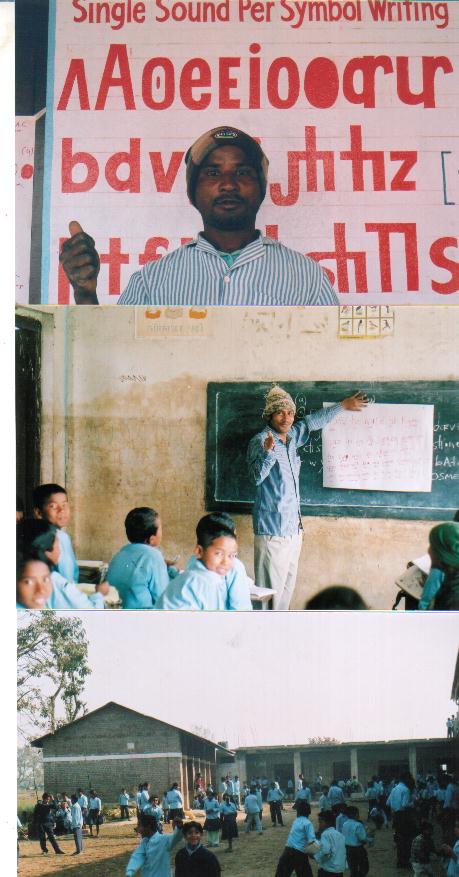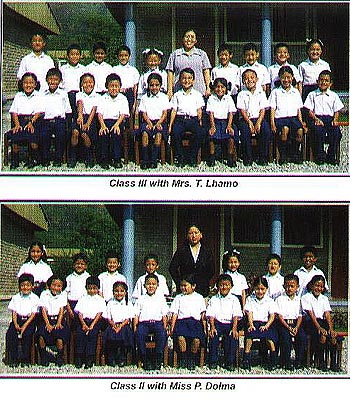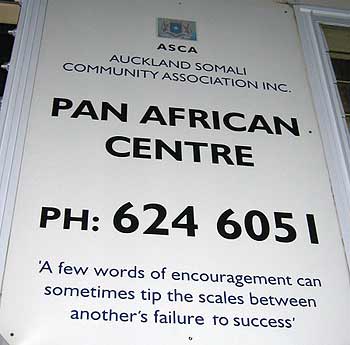It came about from travelling through India and Nepal and trying to learn to speak Nepali and Hindi from guide and language books with Latin/Roman alphabet transliterations. The thing you notice from doing this is that they each make different assumptions on what the 26 English letters sound for and how to deal with sounds outside of the 26 letter alphabet. In creating new letters by combining the most common letter combinations for these other sounds I came up with this phonetic alphabet and with it an unambiguous pronunciation can be represented.*1
The 'International Phonetic Alphabet' is also a set of unambiguous phoneme (sound unit) symbols though it is seldom used for anything other than complete dictionaries; not guide books or language handbooks. In effect it's symbols as in this one represent lips, tongue, jaw position*2 and presence or absence of vocal cords. The letters in the 'International Phonetic Alphabet'*3 come from a number of sources including Greek and Latin (some Latin letters e.g 'j' in the International Phonetic Alphabet are used for sounds outside of their English sound values). Due to this, from an English speaker's point of view it requires a concerted effort to learn.
From working on this I discovered English has 34 different sounds, one of which occurs in a longer and shorter form changing the meaning of words. These are the difference between 'Art' and 'up' or 'putt' and 'part'.*4 Another important aspect of actual speech is the use of a stop in airflow and sound within a word, a thing one may not initially notice.
So from this English can be said to be made of 35 sound quantums + the use of a silent break. The best way to think of them is the division between voiced and unvoiced sounds. There are 26 voiced (with vocal chords) sounds (11 of which would traditionally be regarded as vowels though this is a somewhat arbitrary division) and 9 unvoiced (without vocal chords) sounds, consonants. 8 of these voiced consonants pair with 8 unvoiced consonants in having approximately the same lips, tongue, and jaw positions except no vocal chords. The 'h' sound has 10 different variants depending on the tongue position of the vowel which follows it*5. 'Dipthongs' are where there is a tongue and/or lips position change over the course of a vowel. These are represented by vowel positions they start and pass through and/or finish on in this movement or by another single symbol. Double vowel / Dipthong spelling requires a greater effort to recognise.
In reality many words are said in a number of different ways by one person let alone different people. When writing in this or any phonetic alphabet one is describing one particular pronunciation at one particular time. An advantage of conventional spelling is that same sounding but different meaning words are often (but not always) different in spelling. Most people with a basic understanding of English writing and pronunciation should be able to learn this phonetic alphabet in a few hours. Many people are able to learn it in a few minutes
Most languages appear to use similar basic sounds, many having less than this set of 36, some with sounds outside of this set of symbols.
A lot of what is taken as a speakers accent is the difference in lips, tongue and jaw position with each phoneme, the size and shape of the person most importantly their head, along with pitch change patterns over words. Pitch is a function of vocal chord tension. Lung pressure is the other variable of speech with greater lung pressure causing more airflow thereby greater volume.
*1 It is arguable which of the 'th'/'Th' symols should be assigned to which sound. The logic behind this arrangement is that the capitalised symbol 'Th' relates to the higher sound, as in musical notation. If someone was more comfortable with the other way around, this could be noted in any piece of writing by placing a line below the vocalised symbol in it's first few uses to notate the presence of vocal chords.
*2 Jaw position effects the tone of the phoneme yet all phonemes can be differentiated without jaw movement.
*3 Due the 'International Phonetic Alphabet's' (I.P.A.s) unintuitive choice of letters, documents written in, commonly dictionaries where it appears most often, are often misspelt. Once the I.P.A.s difficult set of letters are learnt there is the added difficulty of decoding misspellings.
*4 For a long time I was convinced a pure dipthong difference changed the meanings of the words 'pull'/'full' with 'pool'/'fool'. I now believe it is a dipthong change so 'full' ='f(oo)l' while 'fool'='f(oo)wl'. So where this alphabet once described 36 pure phonemes it now describes 35 pure phonemes.
*5 The sound known as 'whispering' is defined by these different variations of the 'h' sound replacing what would otherwise be vowels. The long and short form of 'A' (art and up) is still defined in whispering. Whispering hence is talking without vocal chords being engaged.


SSPS version 1 (as above, left) and version 2 - as downloadable pdfs

Also available: SSPS flash cards (download pdf) 6 symbols per page

150 words (as above) - as a downloadable pdf
In a true picture of the universe, there are an infinite number of subtle variations of sounds produced by people speaking. More accurate than any use of symbols to represent the sounds of speech is a three dimensional grid which shows a detailed picture of tongue and lip positions along with jaw position and vocal chord tension. Depending on the mesh size of the grid, high fidelity differences in tongue and lip position can be shown which go on to affect the resultant tone. Modelling like this requires knowledge of lip muscles, the tongue as an organ and vocal chords as an organ.
Mouth matrix modelling, these are your people..
1. Translate normal written english into phonetic writing and phonetic writing into standard writing.
2. Chose words with a number of pronunciations and write these different pronunciations.
3. Practice writing in the 36 (35 phonemes + silent break) symbol alphabet, then in the 44 alphabet (dipthongs and 'x','c' and 'q') to understand how dipthongs are written.
Maori writing and spelling conventions were set in 1820 by Samuel Lee and Hongi Hika. One of the conventions they set was that 'wh' represented a 'f'* sound and mouth position and 'ng' is the same sound as the English "ng" in 'bring'. Due to this there has remained much confusion in Maori language pronunciation by those not learned in it. In Maori language a line above a vowel, a macron, makes the vowel sound for twice as long. In Maori language a "i" sounds as an "E" e.g. the word "Kiwi". Maori can be said to have 15 letters if 'wh' and 'ng' are thought of as one letter each. A useful term in describing written Maori compared to written English is "Homoglyphic heterophones" which is where a pair of letters look the same in either language but produce different sounds.
*or 'w' mouth position but no vocal chords, depending on accent and opinion
Maori: Single Sound Per Symbol alphabet

One to ten in Maori

Haka

New Haka

Relating Maori language to universal construct

First Paragraph of the Treaty of Waitangi pre amble in S.S.P.S.

Each person who speaks will use a set of words and way of using them unique to any other person.Each speaker will have an accent different to any other speaker. This is important to remember, and somethingthat is seldolm mentioned in conventional writen discusions of phonology.The set of words they speak or understand will likely include words from languages other their primary language.e.g A japaneseperson may use the word 'coca cola' within regular Japanese conversation. The term 'English language'or 'Chinese language' for example may be thought of as a collective consciousness that doesn't haveclear and distinct boundaries. If you think about there only ever being an individual speaker, each with a unique vocalulary overlapping these collective consciounesses, a true more organic view of language and different languages can be had. The success of the way languages are written and the way in which people are encouraged to use language will depend on their relationship to these collective consciounesses.e.g Governments will accept certain norms of spelling but the success ofthese will be determined by their ability to make people use them and these spellings resonace withinthe conciousness of the people as individuals and collectively.
1917/1918 four letters removed from the Russian cyrillic alphabet because these letters had the same sound as others within the alphabet.
Russian spelling reforms of 1918
1928 Literacy was greatly increased in Turkey by the introduction and popularisation of the Latin alphabet replacing the more difficult to use and learn arabic type script.Turkmen alphabet 1, similiar to Turkish alphabet
Death of Turkmenistan president
Video of SSPS explained in four procedures
Universal Language ConstructUniversal writing symbols for Tibet,Taiwan, China, Korea + others
Cyrillic based

Cyrillic, in it's variations used in many other countrys other than Russia-see central asia
ABCD no good


are starting to use it here in Hansdehar India
Great Compassion Boarding School
images from Mustang
www.charliefowler.com/mustang.html | www.myhimalayas.com/mustang
Tibetan Children's Education Centre
Movie from Tibetan Children's Village

Arye, in the valley north of Thame near Mount Everest





GICSN_Cambodia GICSN_Mae Sot GICSN_Nepal GICSN_Laos
The wide world of languages spoken in India
List of languages spoken in India
types of writing systems used where in the world
Writing English with Chinese Characters!!!!!
The International Phonetic Alphabet Association
English language in I.P.A. phonetics
English_as_an_additional_language
International_English_Language_Testing_System
http://www.marxists.org/reference/archive/stalin/works/1950/jun/20.htm
the most used words in english in descending order